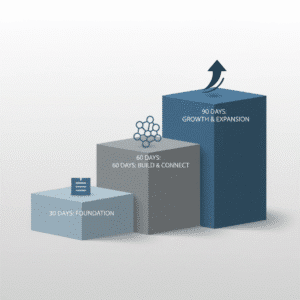
Executive Perspective: The Great Unbundling of Professional Services
The tech services industry stands at an inflection point that will define the next decade of growth.
While traditional firms scramble to “add AI features,” a new category of AI-native competitors is rewriting the economics of services delivery entirely. These firms aren’t just automating tasks: they’re creating what analysts call “Services-as-Software” models that deliver traditional consulting outcomes through repeatable, subscription-based platforms.
The numbers tell the story: AI-native firms achieve 30-40% higher revenue per employee than traditional providers, while reducing delivery timelines by up to 60%. They’re charging for outputs: results, adoption, performance: rather than inputs like hours and headcount.
For Indian tech services firms, this shift presents both existential risk and unprecedented opportunity. The question isn’t whether AI will transform the industry, but whether your firm will lead the transformation or become its casualty.
CUSP POV:
The winners won’t be the biggest firms: they’ll be the fastest integrators of human intelligence and machine capability. AI-driven revenue growth in 2025 depends on reimagining your entire value delivery model, not just adding AI tools to existing processes.
The AI-Native Threat: When Software Eats Services

The New Competitive Reality
A $1.5 trillion Services-as-Software market is emerging, built on a simple premise: automate what can be systematized, amplify what requires human judgment. AI-native firms are achieving what legacy providers have chased for decades: charging for value delivered rather than time spent.
The Economics of Disruption:
These firms understand a fundamental truth: clients don’t want consulting services: they want business problems solved. AI enables direct problem-solving at software speeds with services-level customization.
CUSP POV:
The threat isn’t AI replacing consultants. It’s AI-native firms replacing traditional delivery models while traditional firms debate whether to use ChatGPT for proposal writing.
The Agent Workforce Revolution: Doubling Your Knowledge Workers
Beyond Automation: Intelligence Amplification
The future workforce includes AI agents as digital employees who handle routine inquiries, produce initial code drafts, and transform design concepts into prototypes. Organizations preparing for human-AI collaboration will double their effective knowledge workforce capacity.
The Three-Layer AI Workforce Model:
- Instruction Layer: Humans direct agents on routine tasks
- Iteration Layer: Collaborative problem-solving on complex challenges
- Orchestration Layer: Managing agent teams and optimizing results
Smart firms are creating new management roles specifically for integrating and governing digital workers. This isn’t just about efficiency: it’s about scaling expertise without scaling headcount linearly.
The Mumbai Reality Check
Indian tech services firms have a natural advantage here. Years of managing distributed teams across time zones and cultures translate directly to managing human-AI hybrid workforces. The operational discipline required for 24/7 global delivery maps perfectly to 24/7 AI-augmented delivery.
CUSP POV:
The firms mastering human-AI orchestration today will own the global services market tomorrow. Start with process automation, evolve to cognitive collaboration.
Strategic Advantages: What Traditional Firms Actually Have

The Experience Moat
Despite the AI-native threat, established firms possess hard-won advantages that create defensive moats:
Deep Enterprise Experience: Newer entrants consistently underestimate the complexity of large organizations. Legacy systems, regulatory requirements, change management: these realities favor experienced providers.
Trust and Relationships: Clients seek partners who’ve been in the trenches and can provide accountability when outcomes fall short. This trust takes years to build but provides sustainable competitive advantage.
Domain Expertise: Understanding data privacy, governance, security, and industry-specific regulations becomes more valuable, not less, in the AI era.
Implementation Reality: AI looks easy in demos, gets complex in production. Firms that understand the gap between pilot and production own the value creation zone.
The CUSP Framework: Revenue Growth Through Intelligent Collaboration
Four Pillars of AI-Driven Services Growth
-
Proprietary Data as Competitive Advantage
The choice of large language model matters less than how you leverage AI with institutional knowledge and proprietary datasets. Your firm’s accumulated project learnings, client insights, and domain expertise become training assets for custom AI models.
Framework for Data Monetization:
- Anonymize and structure historical project data
- Build predictive models for common client challenges
- Create AI-powered diagnostic tools specific to your expertise areas
- Package insights as subscription offerings
-
Output-Based Value Pricing
Shift from billing hours to billing outcomes. AI enables this transition by making delivery costs more predictable and scalable.
Pricing Model Evolution:
- Phase 1: Fixed-price projects with AI efficiency gains
- Phase 2: Performance-based pricing tied to business metrics
- Phase 3: Subscription models for ongoing AI-powered insights
-
Hybrid Workforce Orchestration
Design operating models that blend human expertise with AI capability. The goal isn’t replacing people: it’s amplifying their impact.
Implementation Roadmap:
- Identify high-volume, low-complexity tasks for AI automation
- Train teams on AI tool integration and prompt engineering
- Create quality control processes for AI-generated work
- Develop new roles focused on human-AI collaboration
- Platform Business Models
Transform from project-based services to platform-enabled ecosystems. Build repeatable AI-powered solutions that multiple clients can leverage.
CUSP POV:
Revenue growth management comes from transitioning clients from buyers of projects to subscribers of intelligence. The platform model enables this shift while maintaining high-touch relationships.
Implementation Playbook: From Strategy to Execution

The 90-Day AI Transformation Sprint
Days 1-30: Foundation Building
- Audit current processes for AI automation opportunities
- Identify proprietary data assets for model training
- Pilot AI tools with small client projects
- Train core team on AI capabilities and limitations
Days 31-60: Client Value Creation
- Launch AI-augmented service offerings with existing clients
- Develop case studies demonstrating efficiency and outcome improvements
- Begin transitioning pricing conversations from inputs to outputs
- Build feedback loops for continuous improvement
Days 61-90: Scale and Systematize
- Document repeatable AI-enabled processes
- Create training programs for broader team adoption
- Develop platform components for multi-client leverage
- Establish metrics for AI-driven revenue growth
Key Performance Indicators for AI Success
The Bangalore-to-Boston Advantage: Geographic AI Strategy
Leveraging India’s AI Ecosystem
Indian tech services firms have unique positioning advantages in the global AI transformation:
Talent Density: Access to AI/ML engineers at scale enables rapid capability building
Cost Structure: Lower operational costs support experimentation and R&D investment
Global Experience: Multi-cultural project experience translates to multi-modal AI applications
Process Discipline: Established quality frameworks adapt well to AI governance requirements
The key is translating these structural advantages into client value propositions that command premium pricing in global markets.
Risk Management: The Responsible AI Imperative
Building Trust Through Transparency
As AI capabilities expand, so does the importance of responsible implementation. Clients increasingly demand transparency about AI usage, data handling, and decision-making processes.
Essential Governance Framework:
- Clear disclosure of AI involvement in project deliverables
- Robust data privacy and security protocols
- Human oversight requirements for critical decisions
- Bias detection and mitigation processes
- Audit trails for AI-generated recommendations
CUSP POV:
Responsible AI isn’t a compliance burden: it’s a competitive differentiator. Clients will choose providers who demonstrate trustworthy AI practices over those who prioritize efficiency alone.
The Path Forward: Strategic Questions for Leaders
Coming to the usage of AI for tech services firms, considering the services industry transformation, every tech firm must answer four critical questions:
- Are we treating AI as a tool or a transformation catalyst? Tools optimize existing processes; catalysts enable new business models.
- How fast can we shift client conversations from cost reduction to value creation? The firms that reframe AI discussions around business outcomes will capture premium pricing.
- What proprietary advantages can we build that AI-native competitors cannot easily replicate? Deep domain expertise and client trust remain human-centric differentiators.
- How do we balance automation efficiency with relationship intimacy? The sweet spot is using AI to handle routine work while humans focus on strategic partnership.
The next 18 months will separate industry leaders from followers. The firms that act decisively on AI integration: not just adoption: will define the future of tech services.
Ready to transform your services delivery model for the AI era? As a leading growth strategy consulting firm, CUSP’s execution-driven consulting helps tech services firms build systematic approaches to AI integration, from strategy development to revenue growth implementation. Let’s discuss how these frameworks apply to your specific market position and growth objectives.



